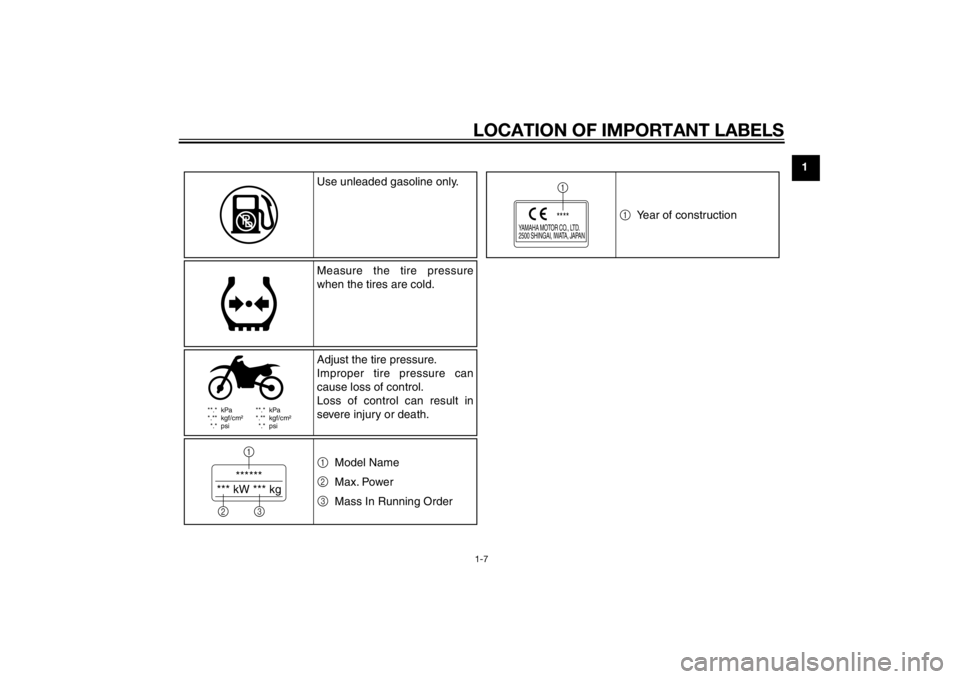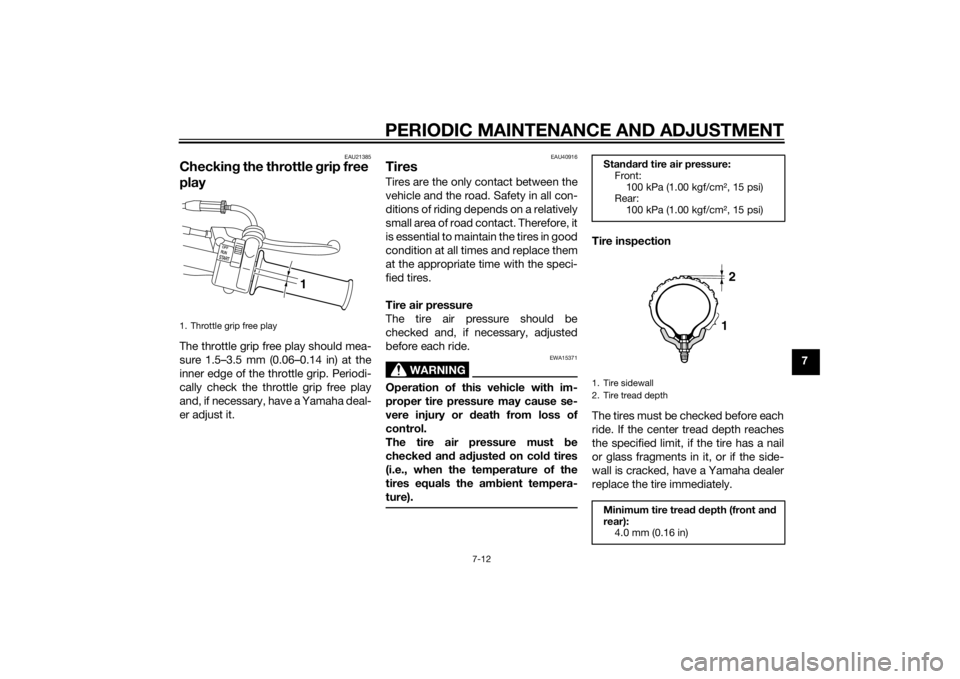2015 YAMAHA PW50 tires
[x] Cancel search: tiresPage 9 of 76

TABLE OF CONTENTS
LOCATION OF IMPORTANT
LABELS..............................................1-1
SAFETY INFORMATION ...................2-1
DESCRIPTION ...................................3-1
Left view ..........................................3-1
Right view ........................................3-2
Controls and instruments ................3-3
INSTRUMENT AND CONTROL
FUNCTIONS .......................................4-1
Handlebar switch ............................4-1
Speed limiter and power reduction plate .............................................4-1
Front brake lever .............................4-2
Rear brake lever ..............................4-3
Fuel tank cap ...................................4-3
Fuel ..................................................4-3
Fuel tank breather hose...................4-5
2-stroke engine oil ...........................4-6
Fuel cock .........................................4-6
Starter (choke) lever .......................4-7
Kickstarter .......................................4-7
Seat .................................................4-7
Cable lock (for Europe) ....................4-8 FOR YOUR SAFETY –
PRE-OPERATION CHECKS
............. 5-1
OPERATION AND IMPORTANT
RIDING POINTS ................................ 6-1
Starting and warming up a cold engine .......................................... 6-1
Starting a warm engine................... 6-1
Starting off ...................................... 6-2
Acceleration and deceleration ........ 6-2
Braking............................................ 6-2
Engine break-in............................... 6-3
Parking ............................................ 6-4
PERIODIC MAINTENANCE AND
ADJUSTMENT .................................. 7-1
Owner’s tool kit............................... 7-2
Periodic maintenance chart for the
emission control system ............. 7-3
General maintenance and
lubrication chart .......................... 7-4
Checking the spark plug................. 7-6
Removing the power reduction plate............................................. 7-7
Transmission oil .............................. 7-8
Middle and final gear cases ............ 7-9
Cleaning the air filter element ......... 7-9
Cleaning the spark arrester .......... 7-10
Adjusting the carburetor ............... 7-11
Adjusting the engine idling speed......................................... 7-11 Checking the throttle grip free
play ............................................ 7-12
Tires .............................................. 7-12
Panel wheels ................................. 7-14
Adjusting the front and rear brake lever free play ............................ 7-14
Checking the front and rear brake shoes ......................................... 7-15
Checking and lubricating the cables ........................................ 7-16
Checking and lubricating the
throttle grip and cable ............... 7-16
Adjusting the Autolube pump ....... 7-16
Lubricating the front and rear brake levers ............................... 7-17
Checking and lubricating the centerstand ................................ 7-17
Checking the front fork ................. 7-17
Checking the steering ................... 7-18
Checking the wheel bearings ........ 7-18
Front wheel ................................... 7-19
Rear wheel .................................... 7-20
Troubleshooting ............................ 7-23
Troubleshooting chart ................... 7-24
MOTORCYCLE CARE AND
STORAGE .......................................... 8-1
Matte color caution ......................... 8-1
Care................................................. 8-1
Storage............................................ 8-3
U2SA81E0.book Page 1 Monday, June 2, 2014 2:00 PM
Page 17 of 76

LOCATION OF IMPORTANT LABELS1-7
1
**.* kPa
*.** kgf/cm²*.* psi **.* kPa
*.** kgf/cm²
*.* psi
******
*** kW *** kg1
23
YAMAHA MOTOR CO., LTD.
2500 SHINGAI, IWATA, JAPAN
****1
Use unleaded gasoline only.
Measure the tire pressure
when the tires are cold.
Adjust the tire pressure.
Improper tire pressure can
cause loss of control.
Loss of control can result in
severe injury or death.
1
2
3 Model Name
Max. Power
Mass In Running Order 1
Year of construction
U2SA81E0.book Page 7 Monday, June 2, 2014 2:00 PM
Page 22 of 76

SAFETY INFORMATION
2-3
2soning, leave the area immediately, get
fresh air, and SEEK MEDICAL TREAT-
MENT.
Do not run engine indoors. Even if
you try to ventilate engine exhaust
with fans or open windows and
doors, carbon monoxide can rap-
idly reach dangerous levels.
Do not run engine in poorly venti-
lated or partially enclosed areas
such as barns, garages, or car-
ports.
Do not run engine outdoors where
engine exhaust can be drawn into
a building through openings such
as windows and doors.
Loa din g
Adding accessories to your motorcycle
can adversely affect stability and han-
dling if the weight distribution of the
motorcycle is changed. To avoid the
possibility of an accident, use extreme
caution when adding accessories to
your motorcycle. Use extra care when
riding a motorcycle that has added ac-
cessories. Here are some general
guidelines to follow if adding accesso-
ries to your motorcycle: Operation of an overloa
ded vehicle
coul d cause an acci dent.
The weight of the operator must
not exceed 25 kg (55 lb).
Accessory weight should be kept
as low and close to the motorcy-
cle as possible. Securely pack
your heaviest items as close to the
center of the vehicle as possible
and make sure to distribute the
weight as evenly as possible on
both sides of the motorcycle to
minimize imbalance or instability.
Shifting weights can create a sud-
den imbalance. Make sure that
accessories are securely attached
to the motorcycle before riding.
Check accessory mounts fre-
quently.
• Properly adjust the suspension for your load (suspension-ad-
justable models only), and
check the condition and pres-
sure of your tires.
• Never attach any large or heavy items to the handlebar, front
fork, or front fender. Genuine Yamaha Accessories
Choosing accessories for your vehicle
is an important decision. Genuine
Yamaha accessories, which are avail- able only from a Yamaha dealer, have
been designed, tested, and approved
by Yamaha for use on your vehicle.
Many companies with no connection
to Yamaha manufacture parts and ac-
cessories or offer other modifications
for Yamaha vehicles. Yamaha is not in
a position to test the products that
these aftermarket companies produce.
Therefore, Yamaha can neither en-
dorse nor recommend the use of ac-
cessories not sold by Yamaha or
modifications not specifically recom-
mended by Yamaha, even if sold and
installed by a Yamaha dealer.
Aftermarket Parts, Accessories, an d
Mo difications
While you may find aftermarket prod-
ucts similar in design and quality to
genuine Yamaha accessories, recog-
nize that some aftermarket accesso-
ries or modifications are not suitable
because of potential safety hazards to
you or others. Installing aftermarket
U2SA81E0.book Page 3 Monday, June 2, 2014 2:00 PM
Page 23 of 76

SAFETY INFORMATION
2-4
2
products or having other modifications
performed to your vehicle that change
any of the vehicle’s design or operation
characteristics can put you and others
at greater risk of serious injury or
death. You are responsible for injuries
related to changes in the vehicle.
Keep the following guidelines in mind,
as well as those provided under “Load-
ing” when mounting accessories.
Never install accessories that
would impair the performance of
your motorcycle. Carefully inspect
the accessory before using it to
make sure that it does not in any
way reduce ground clearance or
cornering clearance, limit suspen-
sion travel, steering travel or con-
trol operation.
• Accessories fitted to the han- dlebar or the front fork area can
create instability due to improp-
er weight distribution. If acces-
sories are added to the
handlebar or front fork area,
they must be as lightweight as
possible and should be kept to
a minimum. • Bulky or large accessories may
seriously affect the stability of
the motorcycle. Wind may at-
tempt to lift the motorcycle, or
the motorcycle may become
unstable in cross winds.
• Certain accessories can dis- place the operator from his or
her normal riding position. This
improper position limits the
freedom of movement of the
operator and may limit control
ability, therefore, such accesso-
ries are not recommended.
Use caution when adding electri-
cal accessories. If electrical ac-
cessories exceed the capacity of
the motorcycle’s electrical sys-
tem, an electric failure could re-
sult, which could cause a
dangerous loss of lights or engine
power.
Aftermarket Tires an d Rims
The tires and rims that came with your
motorcycle were designed to match
the performance capabilities and to
provide the best combination of han-
dling, braking, and comfort. Other tires, rims, sizes, and combinations
may not be appropriate. Refer to page
7-12 for tire specifications and more in-
formation on replacing your tires.
Transportin
g the Motorcycle
Be sure to observe following instruc-
tions before transporting the motorcy-
cle in another vehicle. Remove all loose items from the
motorcycle.
Check that the fuel cock is in the
“S” (stop) position and that there
are no fuel leaks.
Point the front wheel straight
ahead on the trailer or in the truck
bed, and choke it in a rail to pre-
vent movement.
Shift the transmission in gear (for
models with a manual transmis-
sion).
Secure the motorcycle with tie-
downs or suitable straps that are
attached to solid parts of the mo-
torcycle, such as the frame or up-
per front fork triple clamp (and not,
for example, to rubber-mounted
handlebars or turn signals, or
parts that could break). Choose
U2SA81E0.book Page 4 Monday, June 2, 2014 2:00 PM
Page 37 of 76

FOR YOUR SAFETY – PRE-OPERATION CHECKS
5-2
5
Throttle grip • Make sure that operation is smooth.
• Check throttle grip free play.
• If necessary, have Yamaha dealer adjust throttle grip free play and lubricate ca-
ble and grip housing. 7-12, 7-16
Control ca bles • Make sure that operation is smooth.
• Lubricate if necessary.
7-16
Wheels an d tires • Check for damage.
• Check tire condition and tread depth.
• Check air pressure.
• Correct if necessary. 7-12, 7-14
Brake levers • Make sure that operation is smooth.
• Lubricate lever pivoting points if necessary. 7-17
Centerstan d • Make sure that operation is smooth.
• Lubricate pivot if necessary.
7-17
Chassis fasteners • Make sure that all nuts, bolts and screws are properly tightened.
• Tighten if necessary. —
En gine stop switch • Check operation. 4-1
ITEM CHECKS PAGE
U2SA81E0.book Page 2 Monday, June 2, 2014 2:00 PM
Page 45 of 76

PERIODIC MAINTENANCE AND ADJUSTMENT
7-4
7
EAU4175B
General maintenance and lu brication chartTIPItems marked with an asterisk should be performed by a Yamaha dealer as they require special tools, data and technical
skills.NO. ITEM CHECK OR MAINTENANCE JOB INITIAL
THEREAFTER
EVERY
1
month 3
months 6
months 6
months 12
months
1* Front brake
Check operation.Adjust brake lever free play.Replace brake shoes. Whenever worn to the limit
2* Rear brakeCheck operation.Adjust brake lever free play.Replace brake shoes. Whenever worn to the limit
3* WheelsCheck runout and for damage.Replace if necessary.
4* TiresCheck tread depth and for damage.Replace if necessary.Check air pressure.Correct if necessary.
5* Wheel bearingsCheck bearings for smooth operation.Replace if necessary.
7*Check for grease leakage.Check gears for damage and wear.Lubricate gears with lithium-soap-based grease. Every 2 years
Middle and final gear
casesCheck bearing assemblies for looseness.Moderately repack with lithium-soap-based
grease.
Every 2 years
6*
Steering bearings
U2SA81E0.book Page 4 Monday, June 2, 2014 2:00 PM
Page 53 of 76

PERIODIC MAINTENANCE AND ADJUSTMENT
7-12
7
EAU21385
Checking the throttle grip free
playThe throttle grip free play should mea-
sure 1.5–3.5 mm (0.06–0.14 in) at the
inner edge of the throttle grip. Periodi-
cally check the throttle grip free play
and, if necessary, have a Yamaha deal-
er adjust it.
EAU40916
TiresTires are the only contact between the
vehicle and the road. Safety in all con-
ditions of riding depends on a relatively
small area of road contact. Therefore, it
is essential to maintain the tires in good
condition at all times and replace them
at the appropriate time with the speci-
fied tires.
Tire air pressure
The tire air pressure should be
checked and, if necessary, adjusted
before each ride.
WARNING
EWA15371
Operation of this vehicle with im-
proper tire pressure may cause se-
vere injury or d eath from loss of
control.
The tire air pressure must be
checked and a djuste d on col d tires
(i.e., when the temperature of the
tires equals the am bient tempera-
ture).
Tire inspection
The tires must be checked before each
ride. If the center tread depth reaches
the specified limit, if the tire has a nail
or glass fragments in it, or if the side-
wall is cracked, have a Yamaha dealer
replace the tire immediately.
1. Throttle grip free play
1
Stan dar d tire air pressure:
Front:
100 kPa (1.00 kgf/cm², 15 psi)
Rear:
100 kPa (1.00 kgf/cm², 15 psi)
1. Tire sidewall
2. Tire tread depth
Minimum tire trea d d epth (front an d
rear): 4.0 mm (0.16 in)
12
U2SA81E0.book Page 12 Monday, June 2, 2014 2:00 PM
Page 54 of 76

PERIODIC MAINTENANCE AND ADJUSTMENT
7-13
7Tire information
This model is equipped with tube tires.
Tires age, even if they have not been
used or have only been used occasion-
ally. Cracking of the tread and sidewall
rubber, sometimes accompanied by
carcass deformation, is an evidence of
ageing. Old and aged tires shall be
checked by tire specialists to ascertain
their suitability for further use.
WARNING
EWA10462
The front an
d rear tires shoul d b e of
the same make an d d esi gn, other-
wise the han dlin g characteristics of
the vehicle may be different, which
coul d lea d to an acci dent.After extensive tests, only the tires list-
ed below have been approved for this
model by Yamaha.
WARNING
EWA15542
Have a Yamaha dealer replace
excessively worn tires. Operat-
in g the motorcycle with exces-
sively worn tires decreases
ri din g sta bility an d can lead to
loss of control.
The replacement of all wheel-
and b rake-relate d parts, inclu d-
in g the tires, shoul d b e left to a
Yamaha dealer, who has the
necessary professional knowl-
e dge an d experience.
It is not recommen ded to patch
a punctured tube. If unavoi d-
a b le, however, patch the tu be
very carefully an d replace it as
soon as possi ble with a hi gh-
quality pro duct.
Ride conservatively after
chan gin g a tire since the tire
must seat itself on the rim prop-
erly. Failure to allow proper
seatin g may cause tire failure,
which may result in damag e to
the motorcycle an d injury to the
ri der.Front tire:
Size:
2.50-10 4PR
Manufacturer/model:
BRIDGESTONE/M29
PW50 IRC/Z MARK II (ZAF)
PW50F IRC/Z MARK II
PW50F1 IRC/Z MARK II
Rear tire: Size:
2.50-10 4PR
Manufacturer/model: BRIDGESTONE/M29
PW50 IRC/Z MARK II (ZAF)
PW50F IRC/Z MARK II
PW50F1 IRC/Z MARK II
U2SA81E0.book Page 13 Monday, June 2, 2014 2:00 PM